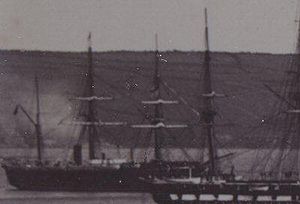HMS Mullett (1860)
 HMS Pandora, sister-ship to HMS Mullett | |
| Career (United Kingdom) | |
|---|---|
| Name: | HMS Mullett |
| Ordered: | 14 June 1859 |
| Builder: | Charles Lungley, Rotherhithe |
| Launched: | 3 February 1860 |
| Commissioned: | 30 April 1862 |
| Fate: | Sold at Hong Kong on 25 April 1872 |
| Career (United Kingdom) | |
| Name: | Formosa |
| Acquired: |
Purchased from the Royal Navy in 1872 Engines removed, converted to a sailing barque |
| Fate: |
Purchased by the Government of Victoria in late 1880s as a blockship Converted to a magazine in 1890 |
| General characteristics | |
| Class and type: | Philomel-class wooden screw gunvessel |
| Displacement: | 570 tons |
| Length: |
145 ft (44.2 m) oa 127 ft 10.25 in (39.0 m) pp |
| Beam: | 25 ft 4 in (7.7 m) |
| Depth of hold: | 13 ft (3.96 m) |
| Installed power: | 355 indicated horsepower (265 kW) |
| Propulsion: |
|
| Speed: | 10 knots (19 km/h) |
| Complement: | 60 |
| Armament: |
Later:
|
HMS Mullett (or Mullet) was a Royal Navy 5-gun Philomel-class wooden screw gunvessel launched in 1860. She served on the coast of West Africa and on the North America and West Indies Station before being sold in 1872 at Hong Kong for mercantile use. As the sailing ship Formosa she sailed in the Far East before being converted to a magazine in Melbourne.
Contents
Design
The Philomel-class gunvessels were an enlargement of the earlier Algerine-class gunboat of 1856. The first 18 of the class were ordered by the Admiralty on 14 June 1859, receiving their names on 24 September the same year. They were constructed of wood in contract yards and then fitted out at naval dockyards.[1]
Construction
Mullett was laid down at the Rotherhithe yard of Charles Lungley on 29 June 1859 and launched on 3 February 1860. She was fitted with a Robert Napier & Sons two-cylinder horizontal single-expansion steam engine driving a single screw and developing 355 indicated horsepower (265 kW).[1]
She was fitted out at Deptford Dockyard, and this would have included her armament of a 68-pounder 95 cwt muzzle-loading smooth-bore gun, two 24-pounder howitzers and two 20-pounder breech-loading guns. All ships of the class later had the 68-pounder replaced by a 7-inch/110-pounder breech-loading gun. The class were fitted with a barque-rigged sail plan.[1]
West Africa (1862 - 1866)
After commissioning at Sheerness on 30 April 1862, she sailed for the West Africa Squadron under the command of Commander Cortland Herbert Simpson. She stayed there for a number of years and participated in at least one punitive expedition.
On an evening in October 1862, open mutiny broke out in the Gold Coast Artillery Corps at Cape Coast. The authorities dispatched Mullett to Accra to forestall a similar outbreak. There was no loss of life. Although 80 mutineers were court martialled and two were sentenced to death, their sentences were commuted.[2]
On 28 June 1866, Mullett, under Captain Robinson, and in company with the small colonial steamer Dover, landed a force of about 400 British troops under Colonel D'Arcy, primarily from the West India Regiment, at Bathurst in The Gambia. The force, joined by local allies, stormed a Marabout stronghold after Mullett had ineffectively shelled the stockade with her 68-pounder for four hours. The British suffered several dead in their attack.[3]
North America and West Indies Station (1867 - 1870)
From 7 November 1867 Commander Edward Kelly commanded Mullett on the North America and West Indies Station. In 1869, while the ship was in Jamaica, Able Seaman William Wardell won a Royal Humane Society Bronze Medal for saving the life on 10 June of Robert Cleal, an Armourer of Terror. Cleal had fallen overboard and Wardell jumped in, holding Cleal above water until a lifebuoy was thrown to him. Cleal was unconscious when brought aboard Mullett but was revived.[4] Mullett paid off at Sheerness on 19 July 1870.[5]
Mercantile service (1872 - 1890)
The Admiralty sold her in Hong Kong on 25 April 1872 for mercantile use. She had her engines removed by W Walker & Co of London, converting her to a barque-rigged sailing vessel. Under the name Formosa she made several voyages to the Antipodes.[6]
Ultimately she was purchased at Melbourne. Then during the Russian war scare in the late 1880s, the government of Victoria bought several old vessels, including Formosa as blockships for the south and west channels. The scare passed and in 1890 the government converted Formosa to a magazine.[6]
Notes
- ↑ 1.0 1.1 1.2 Winfield, p.222
- ↑ De Graft-Johnson (1986), p.168.
- ↑ Once a week, Volume 26, p.568-570.
- ↑ Specialist Medals website
- ↑ "HMS Mullett at the William Loney website". http://www.pdavis.nl/ShowShip.php?id=1792. Retrieved 2010-02-10.
- ↑ 6.0 6.1 Evening Post (1890)
References
- Colledge, J. J.; Warlow, Ben (2006) [1969]. Ships of the Royal Navy: the complete record of all fighting ships of the Royal Navy (Rev. ed.). London: Chatham. ISBN 9781861762818. OCLC 67375475.
- Winfield, Rif; Lyon, David (2003). The Sail and Steam Navy List, 1815-1889. Chatham Publishing. ISBN 978-1861760326.
- De Graft-Johnson, John Coleman (1986) African glory: the story of vanished Negro civilizations.(Baltimore, MD: Black Classic Press).
- "An Historic Vessel", Evening Post, Rōrahi XXXIX, Putanga 82, 9 Paengawhāwhā 1890, Page 3
| |||||||||||
